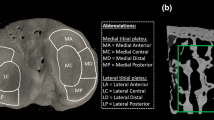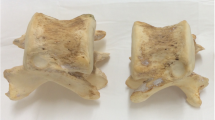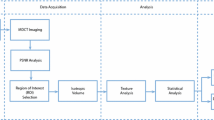Abstract
The objective of this study was to determine if three-dimensional (3D) Haralick co-occurrence texture measures calculated from low-resolution CT images of trabecular bone correlate with 3D structural indices measured from high-resolution CT images. Thirty-three cubical regions of trabecular bone from human calcanei were analyzed using images obtained from a micro-computed tomography (micro-CT) scanner. 3D measures of bone architecture were calculated. The original images were then subsampled by factors of 5, 10, 15, and 20, and 3D texture features were calculated for each set of subsampled images. Linear regression models showed that co-occurrence texture features were significantly correlated with structural indices. Over 90% of the variation in three different structural indices was explained in two-variable regression models using texture features as predictors when the voxel side length was reduced by a factor of 10. Texture features calculated from clinical images may increase our ability to obtain trabecular bone architectural information when high-resolution images are unobtainable.




Similar content being viewed by others
References
Singer K, Edmonston S, Ray D et al (1995) Prediction of thoracic and lumbar vertebral body compressive strength: Correlations with bone mineral density and vertebral region. Bone 17:167–174
Bouxsein ML, Courtney AC, Hayes WC (1995) Ultrasound and densitometry of the calcaneus correlate with failure loads of cadaveric femurs. Calcif Tissue Int 56:99–103
Goldstein SA, Goulet R, McCubbrey D (1993) Measurement and significance of three-dimensional architecture to the mechanical integrity of trabecular bone. Calcif Tissue Int 53:S127–S133
Goulet RW, Goldstein SA, Ciarelli MJ et al (1994) The relationship between the structural and orthogonal compressive properties of trabecular bone. J Biomech 27:375–389
Odgaard A, Andersen K, Ullerup R et al (1994) Three-dimensional reconstruction of entire vertebral bodies. Bone 15:335–342
Feldkamp LA, Goldstein SA, Parfitt AM et al (1989) The direct examination of three-dimensional bone architecture in vitro by computed tomography. J Bone Miner Res 4:3–11
Rüegsegger P, Koller B, Müller R (1996) A microtomographic system for the nondestructive evaluation of bone architecture. Calcif Tissue Int 58:24–29
Müller R, Hahn M, Vogel M et al (1996) Morphometric analysis of noninvasively assessed bone biopsies: Comparison of high-resolution computed tomography and histologic sections. Bone 18:215–220
Müller R, Campenhout H, Damme B et al (1998) Morphometric analysis of human bone biopsies: A quantitative structural comparison of histological sections and micro-computed tomography. Bone 23:59–66
Hildebrand T, Rüegsegger P (1997) A new method for the model-independent assessment of thickness in three-dimensional images. J Microsc 185:67–75
Odgaard A, Gundersen HJG (1993) Quantification of connectivity in cancellous bone, with special emphasis on 3-D reconstructions. Bone 14:173–182
Odgaard A (1997) Three-dimensional methods for quantification of cancellous bone architecture. Bone 20:315–328
Hildebrand T, Laib A, Müeller R et al (1999) Direct three-dimensional morphometric analysis of human cancellous bone: Microstructural data from spine, femur, iliac crest, and calcaneus. J Bone Miner Res 14:1167–1174
Link TM, Majumdar S, Grampp S et al (1999) Imaging of trabecular bone structure in osteoporosis. Eur Radiol 9:1781–1788
Link TM, Bauer JS (2002) Imaging of trabecular bone structure. Semin Musculoskelet Radiol 6:253–261
Gordon CL, Lang TF, Augat P et al (1998) Image-based assessment of spinal trabecular bone structure from high-resolution CT images. Osteoporos Int 8:317–325
Laib A, Rüegsegger P (1999) Comparison of structure extraction methods for in vivo trabecular bone measurements. Comput Med Imaging Graph 23:69–74
Laib A, Rüegsegger P (1999) Calibration of trabecular bone structure measurements of in vivo three-dimensional peripheral quantitative computed tomography with 28-µm-resolution microcomputed tomography. Bone 24:35–39
Saha PK, Wehrli FW (2004) Measurement of trabecular bone thickness in the limited resolution regime of in vivo MRI by fuzzy distance transform. IEEE Trans Med Imaging 23:53–62
Dougherty G (2001) A comparison of the texture of computed tomography and projection radiography images of vertebral trabecular bone using fractal signature and lacunarity. Med Eng Phys 23:313–321
Dougherty G, Henebry GM (2002) Lacunarity analysis of spatial pattern in CT images of vertebral trabecular bone for assessing osteoporosis. Med Eng Phys 24:129–138
Majumdar S, Lin J, Link T et al (1999) Fractal analysis of radiographs: Assessment of trabecular bone structure and prediction of elastic modulus and strength. Med Phys 26:1330–1340
Veenland JF, Link TM, Konermann W et al (1997) Unraveling the role of structure and density in determining vertebral bone strength. Calcif Tissue Int 61:474–479
Link TM, Majumdar S, Lin JC et al (1998) Assessment of trabecular structure using high-resolution CT images and texture analysis. J Comput Assist Tomogr 22:15–24
Cortet B, Dubois P, Boutry N et al (1999) Image analysis of the distal radius trabecular network using computed tomography. Osteoporos Int 9:410–419
Latson L, Kuban B, Bryan J, Stredney D, Davros W, Midura R, Apte S, Powell K (2003) X-ray micro-computed tomography system: Novel applications in bone imaging. Proceedings of the 25th International Conference of the IEEE Engineering in Medicine and Biology Society. 2:1058–1061
Grass M, Kohler T, Proksa R (2000) 3D cone-beam CT reconstruction for circular trajectories. Phys Med Biol 45:329–347
Gonzalez RC, Woods RE (1992) Digital image processing. Addison-Wesley, Reading, MA, USA
Saito T, Toriwaki JI (1994) New algorithms for Euclidean distance transformation of an n-dimensional digitized picture with applications. Pattern Recognition 27:1551–1565
Haralick RM, Shanmugam K, Dinstein I (1973) Textural features for image classification. IEEE Trans Syst Man Cybern SMC 3:610–621
Ulrich D, Rietbergen B, Laib A et al (1999) The ability of three–dimensional structural indices to reflect mechanical aspects of trabecular bone. Bone 25:55–60
Kinney JH, Ladd AJ (1998) The relationship between three-dimensional connectivity and the elastic properties of trabecular bone. J Bone Miner Res 13:839–845
Harrigan TP, Mann RW (1984) Characterization of microstructural anisotropy in orthotropic materials using a second rank tensor. J Mater Sci 19:761–767
Acknowledgements
This work was partially funded by Grant 9820538 from the National Science Foundation (USA)
Author information
Authors and Affiliations
Corresponding author
Rights and permissions
About this article
Cite this article
Showalter, C., Clymer, B.D., Richmond, B. et al. Three-dimensional texture analysis of cancellous bone cores evaluated at clinical CT resolutions. Osteoporos Int 17, 259–266 (2006). https://doi.org/10.1007/s00198-005-1994-1
Received:
Accepted:
Published:
Issue Date:
DOI: https://doi.org/10.1007/s00198-005-1994-1




